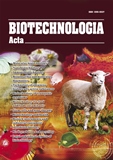ISSN 2410-7751 (Print)
ISSN 2410-776X (Online)

Biotechnologia Acta Т. 17, No. 2 , 2024
P. 70-73, Bibliography 8, Engl.
UDC:: 577
DOI: https://doi.org/10.15407/biotech17.02.070
ANTICOAGULANT PROPERTIES OF RECOMBINANT ANNEXIN А5
D. O. SAVCHENKO 1,2, A. A. SIROMOLOT 1,3, A. O. PAVLENKO 1
1 Palladin Institute of Biochemistry of the National Academy of Sciences of Ukraine, Kyiv
2 National University “Kyiv-Mohyla Academy”, Kyiv, Ukraine
3 Taras Shevchenko National University of Kyiv, Ukraine
Aim: Because of its involvement in membrane properties, annexin A5 has a significant impact on membrane-dependent processes within hemostasis, including the initiation of the coagulation cascade, the activation of factor X and prothrombin, and the function of protein C on membrane surfaces. By binding to phosphatidylserine, annexin A5 acts as a protective shield, masking exposed phospholipid surfaces and exerting a general anticoagulant effect. Considering the significant influence of annexin A5 on the activation of hemostatic compounds on cell surfaces, it is crucial to further investigate its mechanisms.
Methods: After purification of polyHis-Tag proteins by immobilized metal affinity chromatography from E. coli Rosetta cell biomass, we checked the purity of the eluate by SDS-PAGE. We performed APTT test, PT test and platelet aggregation to find out the anticoagulation influence of recombinant annexin A5 in these tests.
Results: Annexin in the highest concentration of 40 μg/ml prolonged blood plasma clotting time in activated partial thrombin time by almost 50%, blood plasma clotting time in prothrombin time by almost 15% and did not influence the rate of platelet aggregation.
Conclusion: It can be assumed that its anticoagulant effect is directed to the enzyme complexes of the hemostasis system and does not extend to platelet receptors. The obtained protein can be used to study the activation of hemostatic components on cell surfaces.
Key words: annexin A5, blood coagulation, platelet aggregation, phosphatidylserine, platelets.
REFERENCES
1. Moss S.E., Morgan R.O. The annexins. GenomeBiology.com [Internet]. 2004 Jan 1;5(4):219.
Available from: https://www.researchgate.net/publication/8642674_The_Annexins
2. Bradacova P., Slavik L., Ulehlova J., Skoumalova A., Ullrychova J., Prochazkova J., Hlusi A.,
Manukyan G., Kriegova E. Current Promising Biomarkers and Methods in the Diagnostics of
Antiphospholipid Syndrome: A Review. Biomedicines. 2021, 9(2): 166. https://doi.org/10.3390/
biomedicines9020166
3. Fezoua-Boubegtiten Z., Desbat B., Brisson A., Lecomte S. Determination of molecular groups involved
in the interaction of annexin A5 with lipid membrane models at the air–water interface. Biochimica
et Biophysica Acta (BBA) — Biomembranes. 2010, 1798(6): 1204-1211. https://doi.org/10.1016/j.
bbamem.2010.03.014
4. Rand J. H. The annexinopathies: A new category of diseases. Biochimica et Biophysica Acta
(BBA) — Molecular Cell Research. 2000, 1498(2 3): 169 173. https://doi.org/10.1016/S0167-
4889(00)00093-8
5. Rand J. H. Antiphospholipid Antibody-mediated Disruption of the Annexin-V Antithrombotic
Shield: A Thrombogenic Mechanism for the Antiphospholipid Syndrome. Journal of Autoimmunity.
2000. 15(2): 107–111. https://doi.org/10.1006/jaut.2000.0410
6. Gerke V, Moss S.E. Annexins: From structure to function. Physiological Reviews. 2002, 82(2):331–
71. Available from: https://pubmed.ncbi.nlm.nih.gov/11917092/
7. Dasgupta S, Maity P, Banerjee U, Mukhopadhyay P, Saha S, Das B. Clinicopathological study of
annexin A5 & apelin in pre-eclamptic placentae with emphasis on foetal outcome. Indian Journal of
Medical Research. 2021, 154(6):813. Available from: https://www.ncbi.nlm.nih.gov/pmc/articles/
PMC9347247/
8. Tzima E, Walker J.H. Platelet annexin V: the ins and outs. Platelets. 2000, 11(5):245–51. Available
from: https://www.tandfonline.com/doi/abs/10.1080/09537100050129251
© Palladin Institute of Biochemistry of National Academy of Sciences of Ukraine, 2024

